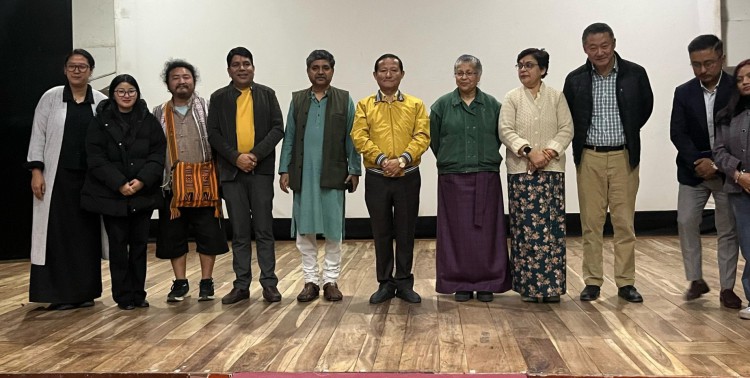




















Saturday, Apr 12, 2025 11:00 [IST]
Last Update: Friday, Apr 11, 2025 17:55 [IST]
GANGTOK, :As part of the
golden jubilee celebrations commemorating 50 years of Sikkim's Statehood, the
Sikkim State Archives, under the aegis of the Culture Department, organized a
comprehensive ten-day ‘Heritage Walk’ workshop from April 1 to 10.
The initiative was conceived
with the objective of deepening public awareness about Sikkim’s rich cultural
heritage—reflected in its art, literature, rituals, and the living traditions
of its diverse ethnic communities.
By seamlessly integrating
cultural education with community participation, the workshop sought to promote
heritage tourism, foster economic opportunities tied to cultural assets, and
reinforce efforts toward the conservation of both tangible and intangible
heritage.
The workshop also witnessed
active participation from various associations in the state, such as the Travel
Association, Homestay Association, Hotel and Restaurant Association, Urban
Development and Housing Department, Gangtok Municipal Corporation, and Sikkim
University.
The inaugural session was
graced by Culture secretary Basant Kumar Lama, additional director B.P. Rai,
and chief engineer Rimp Dorjee Lepcha.
A foundational presentation on
the purpose and structure of the Heritage Walk was delivered by State Archives
research officer Yangchen D. Bhutia.
In his keynote address,
Rimp Dorjee Lepcha emphasized the need for architectural distinction in
structures commissioned by the Culture department.
He articulated that
architecture must not only serve function but also narrate history. Critiquing
the trend of uniform modernity in construction, he urged a revival of
traditional design elements that speak to the unique identity of Sikkim.
Highlighting sustainability,
Lepcha praised bamboo architecture, which dates back over 4,000 years, and
argued for its precedence over Reinforced Cement Concrete (RCC), a relatively
modern invention from the mid-1800s.
He lamented the loss of bamboo
craftsmanship due to the overuse of RCC and advocated that 10–15% of cultural
infrastructure projects should involve local stakeholders, aligning with the
national vision of 'Vocal for Local.'
The second day featured a
presentation by Yangchen D. Bhutia on “How to Build a Business on Heritage
Walks,” outlining strategies to monetize cultural tourism ethically and
sustainably.
Ingsa Subba shared his personal
journey in transforming Sikkim’s heritage into a viable enterprise, followed by
a detailed historical account of White Hall and the Tsuklakhang Monastery and
Palace—both iconic to the State’s architectural legacy.
Participants embarked on a demo
heritage walk led by Ingsa Hang Subba, who guided the delegation through key
historic structures across the capital.
The fourth day featured
in-depth presentations on the Raj Bhavan, Directorate of Handicrafts and
Handloom, and the Ridge Park Gazebo, delving into their architectural evolution
and cultural relevance.
A trial heritage walk was
conducted on the fifth day with Debashish G. Nayak, noted heritage expert,
along with staff from the Culture Department, facilitating hands-on experience
for effective heritage interpretation.
Day seven brought thoughtful
insights from Debashish G. Nayak, fondly known as the "Heritage Man of
Ahmedabad," and founder of the Centre for Heritage Management, Ahmedabad
University, and he is also the architect for Ahmedabad heritage works.
In his presentation titled
“Getting the City Back to Its People,” Nayak explored themes of urban heritage,
community ownership, and place-making.
The day also featured a
compelling talk by Usha Lachungpa, eminent naturalist and environmentalist,
titled “Ecological and Economic Heritage of Sikkim.” She highlighted the
intrinsic relationship between biodiversity and cultural traditions,
underscoring the need to preserve Sikkim’s unique flora and fauna alongside its
cultural assets.
On the eighth day, Prof.
Veenu Panth, historian and member of ICHR Guwahati, delivered an academic
perspective on the region’s cultural timeline.
An interactive open discussion
followed with Debashish G. Nayak, providing participants a forum to share
insights and explore possibilities for enhancing the Heritage Walk model
Day nine celebrated the
artistic heritage of the Lepcha community, with a captivating presentation and
performance by Mickmar Lepcha, showcasing traditional musical instruments and
folk music.
The performance highlighted the
importance of preserving indigenous languages, music, and customs, reinforcing
a deeper sense of cultural pride. The day concluded with a visit to the
Directorate of Handicrafts and Handlooms, providing firsthand exposure to
Sikkim’s traditional craftsmanship.
The final day featured a
presentation by chief architect Gary Chopel, who eloquently reflected on the
imperative to document, preserve, and promote Sikkim’s architectural heritage.
He spoke extensively about the
Cultural Mapping Resource Project, initiated in 2003, which involved the
systematic documentation of historically significant sites throughout the
state.
Chopel provided a compelling
visual and narrative overview of the evolution of ‘Gumpa’ architecture,
intrinsic to the Himalayan monastic tradition, alongside indigenous domestic
architectural forms such as the ‘Kothi’ and ‘Jhingeni’ roofs and other
vernacular styles that articulate the lived heritage of Sikkimese communities.
He underscored the significance
of the curated Heritage Walk—which will be conducted from May 1 to 10—as a
powerful tool to revive public interest and strengthen emotional connections to
build heritage.
The walk encompasses key
landmarks including the Raj Bhavan, Directorate of Handicrafts and Handloom,
State Archives, White Hall, and the Tsuklakhang Palace, enabling participants
to uncover the stories and symbolism embedded within these structures.
Chopel concluded with a
poignant reminder: “Heritage is always at war with time.” He emphasized that
now is the moment to act decisively to safeguard our cultural legacy. He
encouraged active participation in the ongoing Kuzu Cultural Festival and
called upon every citizen to embrace their role as custodians of Sikkim’s
timeless heritage.
